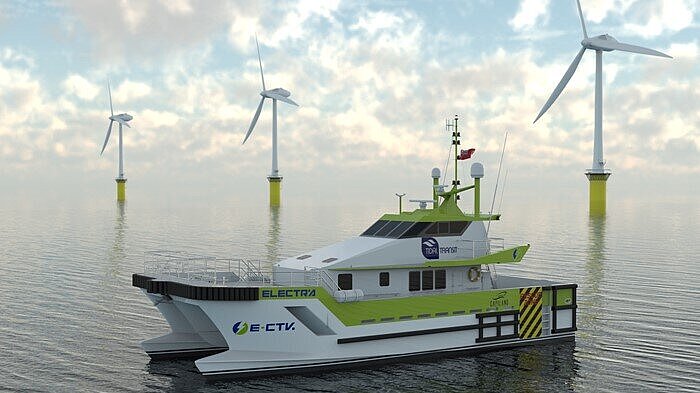CTV to undergo diesel-to-electric conversion

The converted E-CTV vessel will be renamed e-Ginny and will benefit from various features to improve manoeuvrability and seakeeping (Source: Volvo Penta)
A crew transfer vessel (CTV) is to have its diesel engines replaced with a fully electric zero-emission Volvo Penta Inboard Performance System (IPS). The result of the retrofit will be the arrival of the world’s first electric crew transfer vessel, Volvo Penta claims.
The CTV to be converted in the 20m-long Ginny Louise, a Mercurio vessel. The existing diesel setup will be replaced with a Quad Installation of Volvo Penta IPS 30 paired with electric motors and more than 2MW of battery capacity. The converted E-CTV vessel will be renamed e-Ginny and will benefit from various features to improve manoeuvrability and seakeeping.
Part of the project will involve the installation of new charging infrastructure ashore and at offshore wind installations at sea. This combination will increase the range and productivity of the vessel. Upon completion of the retrofit, the E-CTV will begin a three-year crew transfer contract.
By using an existing vessel, Volvo Penta was able to adopt circularity to achieve a more sustainable outcome. This was one of the features that helped the project to qualify for UK Government funding.
It is the latest marine project to use Volvo Penta IPS to achieve more sustainable operations. It follows recent announcements of similar projects with Northern Offshore Services and Sanlorenzo Yachts.
The conversion, being undertaken for UK crew transfer company, Tidal Transit, is expected to cost about GBP 8 million, almost 80% of which will come from the UK Government’s Zero Emissions Vessel and Infrastructure programme.
Jan-Willem Vissers, director Commercial, at Volvo Penta, said: “Our vision is to become world leaders in sustainable power solutions and being selected for this ground-breaking project shows the important steps we are making towards our goal. We believe there are many paths to net-zero, and it’s important we support our customers along whichever route they choose. It’s also important to remember the importance of remanufacturing and circularity in achieving our targets. It’s part of our business where we are putting greater emphasis, and projects such as e-Ginny are a great example of how it can be done.”
Tidal Transit commercial director, Leo Hambro, commented: “The transition to electric crew transfer vessels marks a major step towards achieving a more sustainable and environmentally responsible offshore wind industry. Electrification projects like the e-Ginny retrofit offer great benefits from a national to international scale – alongside a substantial reduction in carbon footprint, the absence of combustion engines also contributes significantly to lowering noise pollution, eliminates the risk of fuel spillages and translates into lower maintenance requirements. With the addition of onshore and offshore charging solutions, these vessels can stay on the water for longer, ultimately reducing operational costs for fleet operators.”
